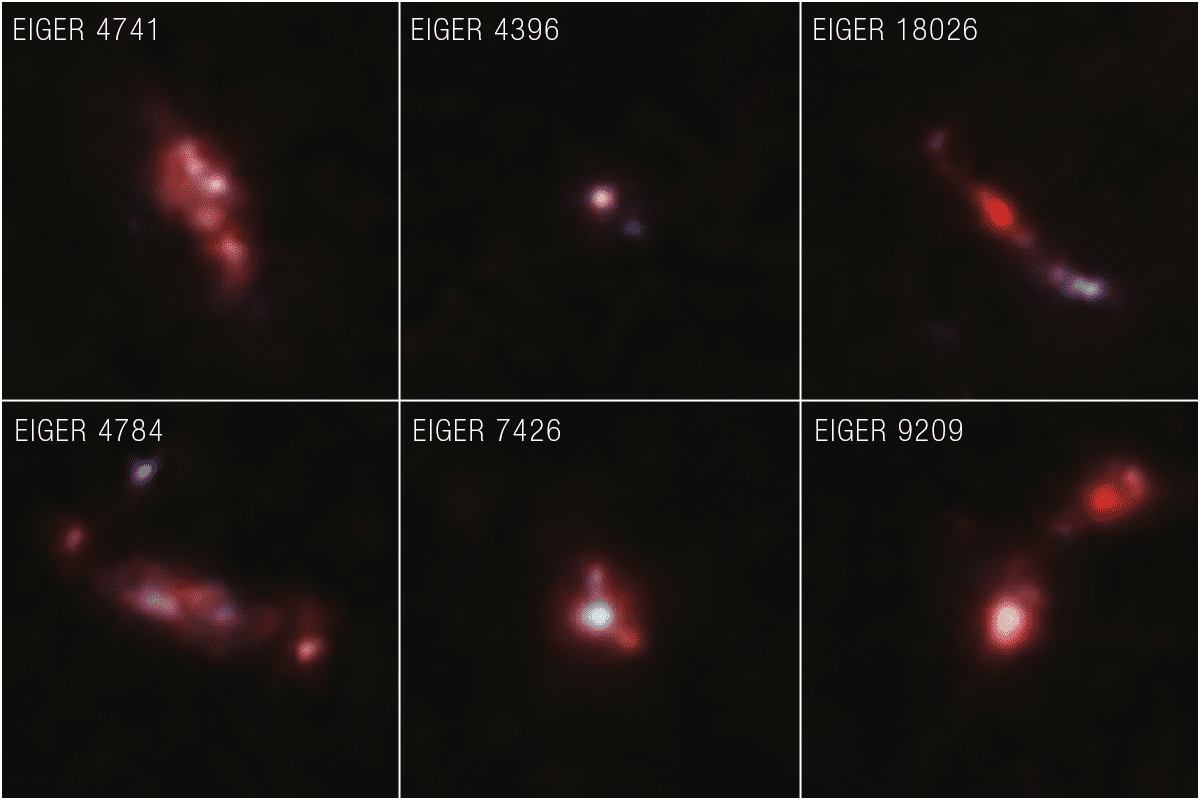During the first billion years or so, the universe was opaque. Starlight was absorbed by the neutral hydrogen that existed in intergalactic space. But the light of the most massive stars ripped the electrons from the hydrogen atoms, making the universe transparent. This is known as the Epoch of Reionization. Bubbles of transparent hot gas formed around galaxies before expanding so much as to merge with their neighbors. And this process has been seen by JWST.
The work is part of the Emission-line galaxies and Intergalactic Gas in the Epoch of Reionization (EIGER) program and has delivered a stunning deep field image of the universe featuring some 20,000 galaxies. Among them, there are objects whose light comes from when the cosmos was just 900 million years old, right in the middle of the Epoch of Reionization. And thanks to JWST, astronomers have been finding plenty of them.
“We expected to identify a few dozen galaxies that existed during the Era of Reionization – but were easily able to pick out 117,” Daichi Kashino of Nagoya University in Japan, the lead author of the team’s first paper, said in a statement.
Courtesy of JWST, the team saw the transparent regions around the galaxies and also measured how large these structures were at the time, proving that these galaxies were changing the early universe. Pivotal to the observations is the quasar at the center of the image.
Quasars, or quasi-stellar objects, look a bit like stars. You will notice the six-spoke features that are an artifact of the telescope optics when it comes to foreground stars. But unlike those other blue-white objects (real stars) in the photo, this one is pink, at the center of the image, and at an enormous distance from us.
Quasars are the active core of galaxies whose central supermassive black hole is gobbling up material at an incredible rate. This one is so bright that can be used as a flashlight to measure the gas between us and all those distant galaxies. This allows the team to study the effect of galaxies on the hydrogen that surrounds them.
“By illuminating gas along our line of sight, the quasar gives us extensive information about the composition and state of the gas,” explained Anna-Christina Eilers of MIT in Cambridge, Massachusetts, the lead author of the team’s third paper.
Six of those very distant galaxies, showing complex never-before-seen structures.
Image credit: NASA, ESA, CSA, Simon Lilly (ETH Zürich), Daichi Kashino (Nagoya University), Jorryt Matthee (ETH Zürich), Christina Eilers (MIT), Rob Simcoe (MIT), Rongmon Bordoloi (NCSU), Ruari Mackenzie (ETH Zürich); image processing: Alyssa Pagan (STScI), Ruari Mackenzie
The work is direct evidence of the role of galaxies and their stars in reionizing the universe. But that is not all. Observations show unprecedented detail in these distant galaxies. They tend to be clumpier, more elongated, and with a lot of new stars forming.
“They are more chaotic than those in the nearby universe,” added Jorryt Matthee, from ETH Zürich and the lead author of the team’s second paper. Odd galaxies are now a standard feature in JWST deep fields.
The EIGER team has five other fields to study, each centered around a central quasar. So expect more incredible images, more insight into the Epoch of Reionization, more details on young galaxies, and hopefully some explanation of quasar growth. J0100+2802, the one in this image, is powered by a supermassive black hole 10 billion times the mass of the Sun. It’s the most massive one known in the early universe and its growth is an open question.
“We still can’t explain how quasars were able to grow so large so early in the history of the universe,” Eilers continued. “That’s another puzzle to solve!”
The first, second and third papers are all published in the latest issue of The Astrophysical Journal.
Source Link: New JWST Deep Field Shows How Galaxies Changed The Universe
